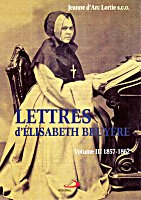
 |
National Library News |
Mary Bond,
Research and Information Services
It is difficult for 20th-century residents of Ottawa to imagine the society of 1840s Bytown to which Élisabeth Bruyère and her small group of companions were sent to establish a house of their religious order. The May SAVOIR FAIRE seminar presented by Sister Rita Lacombe, s.c.o. (museologist of the order) described something of the labours of Sister Jeanne d’Arc Lortie, s.c.o., compiler of the letters of Élisabeth Bruyère. The three volumes of letters cover the years from 1839 to 1862. Through this correspondence, readers can gain a vivid picture of early Ottawa and the role of the Sisters of Charity of Ottawa as one of its first and most significant charitable organizations.
 |
The Archives générales of the Sisters of Charity of Ottawa has in its possession over 1600 letters of Élisabeth Bruyère, including original autographed manuscripts and copies. Volume I (1839-1849) reproduces 178 of these letters, covering the early years of Élisabeth Bruyère’s religious life and the period of the establishment of the order in Bytown. During the course of these years, a convent, a school and a hospital were also founded. The 208 letters of Volume II (1850-1856) describe the period of the separation of the Bytown community from the Hôpital général (Mother House) in Montreal. Volume III (1857-1862), describing various missionary episodes in the history of the convent and Mother Bruyère’s own travels in France, reproduces 226 letters. A fourth volume of letters, covering the latter years of Élisabeth Bruyère’s life, is in progress.
Each of the volumes has a detailed introduction and each letter is accompanied by a brief sketch which places it in context. It is in the detail of the historical, linguistic and critical notes that the reader understands the meticulous and dedicated work of Sister Lortie. For her historical research on the time period, Sister Lortie used the rich collections of the National Library, including newspapers, official publications and reference works, as well as material in the National Archives of Canada.
Sister Lacombe read excerpts from the letters through which the voice and the personality of Élisabeth Bruyère came alive for the audience. We imagined her writing late at night by candlelight, using a quill pen as she describes her first experiences of Bytown and waits impatiently for news from the Hôpital général in Montreal. During her travels in France, she complains of the cost of postage and makes recommendations on various matters to the sisters remaining in Bytown.
Because this seminar was held at the Mother House of the Sisters of Charity (the first SAVOIR FAIRE seminar to be held at a location other than the National Library), participants were treated to a tour of the museum of the Sisters, which included a temporary exhibition of some of the original letters as well as a permanent collection of artifacts such as furniture from the period of the foundation of the order in Bytown. A visit to the chapel and the oratory completed the tour and provided a glimpse of the daily life of the convent, reinforcing the significance of this Bytown pioneer.
The next SAVOIR FAIRE seminar will take place on December 14. Professor Alan Gillmor of Carleton University will present "Taming the Dragon: Using a Voice Recognition Program" (For more information, see the October, 1999 issue of National Library News, p. 9-10.)